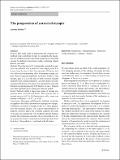| dc.contributor.author | Medina, Antonio | |
| dc.date.accessioned | 2016-11-04T22:23:19Z | |
| dc.date.available | 2016-11-04T22:23:19Z | |
| dc.date.issued | 2015-04 | |
| dc.date.submitted | 2015-03 | |
| dc.identifier.issn | 0721-832X | |
| dc.identifier.issn | 1435-702X | |
| dc.identifier.uri | http://hdl.handle.net/1721.1/105227 | |
| dc.description.abstract | Purpose: This study seeks to demonstrate the existence of a feedback loop controlling myopia by comparing the prediction of a feedback model to the actual progression of corrected myopia. In addition to theoretical results, confirming clinical data are presented. Methods: The refraction of 13 continuously corrected myopic eyes was collected over a period of time ranging from 4 to 9 years from the time of their first correction. Refractive data was collected in an optometry office from myopic young subjects from the general population in Boston. Subjects were myopes, ages 2 to 22 at the time of first correction selected randomly from a larger population. All individuals were fully corrected with lenses; new lenses were prescribed every time that their myopia increased by 0.25 diopters or more. Subjects wore their spectacle lenses during the followed period. Results: Subjects exhibit a linear time course of myopia progression when corrected with lenses. The observed rate of myopia increase is 0.2 to 1.0 diopters/year, with a mean correlation coefficient r = −0.971, p < 0.005. Conclusions: This report establishes that feedback control theory applies to the clinical phenomenon of progressive myopia. Continuous correction of myopia results in a linear progression that increases myopia. The Laplace transformation of temporal refractive data to the s-domain simplifies the study of myopia and emmetropia. The feedback transfer function predicts that continuous correction of myopia results in a linear progression because continuous correction opens the feedback loop. This prediction is confirmed with all subjects. | en_US |
| dc.publisher | Springer Berlin Heidelberg | en_US |
| dc.relation.isversionof | http://dx.doi.org/10.1007/s00417-015-2991-5 | en_US |
| dc.rights | Article is made available in accordance with the publisher's policy and may be subject to US copyright law. Please refer to the publisher's site for terms of use. | en_US |
| dc.source | Springer Berlin Heidelberg | en_US |
| dc.title | The progression of corrected myopia | en_US |
| dc.type | Article | en_US |
| dc.identifier.citation | Medina, Antonio. “The Progression of Corrected Myopia.” Graefe’s Archive for Clinical and Experimental Ophthalmology 253.8 (2015): 1273–1277. | en_US |
| dc.contributor.department | Massachusetts Institute of Technology. Research Laboratory of Electronics | en_US |
| dc.contributor.mitauthor | Medina, Antonio | |
| dc.relation.journal | Graefe's Archive for Clinical and Experimental Ophthalmology | en_US |
| dc.eprint.version | Author's final manuscript | en_US |
| dc.type.uri | http://purl.org/eprint/type/JournalArticle | en_US |
| eprint.status | http://purl.org/eprint/status/PeerReviewed | en_US |
| dc.date.updated | 2016-08-18T15:27:00Z | |
| dc.language.rfc3066 | en | |
| dc.rights.holder | Springer-Verlag Berlin Heidelberg | |
| dspace.orderedauthors | Medina, Antonio | en_US |
| dspace.embargo.terms | N | en |
| mit.license | PUBLISHER_POLICY | en_US |
| mit.metadata.status | Complete | |
